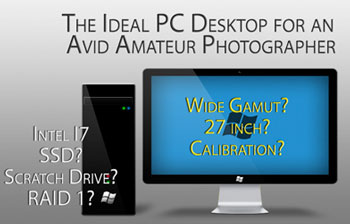
For the past few months, I have been seriously considering replacing my desktop computer with something significantly more powerful than my current equipment. Although my current set up is more than capable of basic word processing and access to the Internet, it falls short of optimum performance when using photo editing software such as Lightroom, Photoshop and CorelDRAW.
Like many who take up the photography hobby, they attempt to use the equipment they have and make it work as best as possible. That has been my situation for the past five years since I started photography in the digital realm.
First it was JPEG storage in a basic library, with basic manipulation and recently it is RAW files edited in Lightroom and Photoshop.
My current computer gear was the top of the line equipment when it was new. A high end Acer 64-bit gaming laptop with a 1GB graphics card, 4GB of RAM, linked to a 24-inch Dell full HD “TN” specked monitor. The laptop is now seven years old and the monitor is 10 years old.
As a Mac user for many years, I have been most impressed with the stability of Windows 7 and likewise impressed with the serviceability of the Dell monitor. When new, the Acer was running the Vista Pro operating system and after slowing to a crawl, a fresh install of OEM Windows 7 Professional 64 Bit was undertaken.

Regardless of how many times I calibrate the monitor with the Spyder hardware, the monitor is far from ideal when editing photos in any program and the speed of the computer is less than ideal with multiple programs are open.
I recently spent six hours stripping malware and other nasties from the laptop, using a combination of eight programs; consecutively. The result was a definite speed increase and it highlighted the fact that one’s main work computer should not be used for certain applications such as accessing torrent sites and other P2P services. A valuable lesson learned.
Chasing whatever speed increase I could achieve with my current set up, I followed the advice of some on the Internet and installed a dedicated USB drive to be used as a ready boost scratch drive. This was a $12 experiment for a 16GB flash drive and it has helped; albiet only when the system is up and running. After a restart, ready boost needs to learn the user’s habits all over again.
An issue one notices when running ready boost and 4GB of RAM is that the 5,400 RPM HD does not spool up as much as it did before. This indicated exactly how much memory Photoshop was using and how much it needed. It also highlighted that 4GB of RAM running large Photoshop files is far from adequate. It would appear that the more RAM the better when using Photoshop.
As an amateur, my knowledge of exactly how Photoshop and other editing suites access memory was minimal. Luckily, the information is readily available on the Internet and there are some sites dedicated to explaining the demands these programs have on computer software and hardware. Photoshop is a RAM hog and when it needs more memory, it uses part of the HD as a scratch disk. The larger the file, the larger amounts of memory the program requires and the more the HD is accessed, after available RAM has been used.
One naturally assumed Lightroom worked in a similar fashion; it is another application within the Adobe Creative Suite. Unfortunately, it does not use the HD to create a scratch disk and therefore there is no benefit installing a dedicated scratch disk for Lightroom use only.
The more I read, the more confusing everything became. One thing was obvious: my desktop and monitor needed replacing in the short term. I had been fortunate with the amount of service I received from both the laptop and the monitor. The more I learned about photography and the more I expected of my own skills in post-processing, the more it became obvious that my equipment was insufficient for my current needs and my future requirements.
After significant research, I have decided to have a PC desktop built in the near future as there is nothing available off the shelf where I live that comes close to what I need. Although I am a fan of Macs, the PC is a more cost-effective option, especially when building a unit for a specific purpose.
I will discuss the build with a local company in the near future, but at this stage I believe the following is required to ensure both Photoshop and Lightroom operate at a satisfactory level:
- Intel I7 4770 or above
- A minimum of 16GB of RAM — many experts believe more RAM (32GB) of lower quality RAM is better than less of slightly higher speed
- 250 SSD for main programs and operating system
- A minimum of 120 GB dedicated to a Photoshop scratch disk
- A minimum of 1GB graphics card that is matched to Adobe programs in performance
- 2 x 3TB 7,200 RPM HD running in RAID 1 (provides redundancy and back up of everything)
- DVD optical reader/writer
- A descent case with sufficient cooling
- Windows 7 64-bit OS
I expect this build to cost around $2,000. Unfortunately, I reside in Thailand and computer parts and expertise are not always available and cost-effective. It has been difficult task to firstly find a company that understands my requirements and is trustworthy to install the parts I will pay for.
One interesting online report measured the access speed of a Lightroom library on both a conventional 7,200 rpm HD and an SSD. The difference in speed of access was minimal. It would appear that when accessing libraries in Lightroom, it is the program itself that dictates the speed of access and not the drive where the library is stored.
Tests indicated that machines with faster processors and more RAM were faster to open Lightroom library files than a slower machine with less RAM and a SSD installed library. The speed of the Lightroom program opening was faster when the machine had an SSD as its main HD, but it was a different case when the library files were accessed.
With the computer research over, I thought the worst was over. I had performed the research and had found a suitable company that understood the specific hardware needs of Adobe editing software. The only item remaining was a new monitor. Surely, that would be a simple process. I wanted a 27-inch monitor and one with the highest definition would be sufficient. I already owned a Spyder 4 hardware calibrater; surely this would ensure that the colors presented on the monitor would be accurate for my editing needs. My next lesson was about to start; the world of color management.
The more I read about monitors specifically designed for photography editing, the more confusing and expensive the available options seemed to be. The Internet is a wonderful tool to access information, but at times the information is conflicting and criticizes other reviews.
I am currently considering Dell UltraSharp monitors. It would appear that Dell monitors offers a medium range of quality best suited for an amateur enthusiast photographer. The model I was interested in (Dell UltraSharp U2711) is a wide gamut monitor and apparently its post calibration is quite accurate. There are conflicting reports about the matt screen coating and the inconstancy of this coating.
Unfortunately, this monitor is no longer available where I live and the next available model is the UltraSharp U2713HM. Once again, there are conflicting reports about this monitor. It is not a wide gamut monitor, but many reports indicate that post calibration the colors are quite accurate. Other reports indicate that the “blacks” are not as saturated as some other monitors and therefore this monitor may not be suitable for editing.
Eizo and NEC definitely appear to be the best monitors on the market for photographic editing, but their cost is at least twice that of monitors aimed at amateur enthusiasts. An additional issue is that both companies do not carry the high-end monitors in Thailand and they are only available via special orders with significant waiting periods.
I was hoping that those experienced in photography may have some input on a suitable monitor for my needs. My requirements are as follows:
- A 24-inch monitor as a minimum. I would prefer a larger monitor (27-inch), but cost is a factor. As stated above, I own a Spyder 4 calibrator and therefore can calibrate any monitor using this hardware.
- 8-bit (10-bit would be nice for future proofing) and preferably capable of sRGB and Adobe RGB. I am the first to admit that editing with Adobe RGB would increase the tonal range of monochrome shots and I enjoy shooting monochrome.
- Wide gamut would be preferable, due to the fact of attaining the Adobe RGB color range.
- Speakers and webcam are not important; they can be added later via third party add ons.
- The lighting in the office where this would be used is stable. There is one fluorescent light in the center of the ceiling and therefore maybe a hood for the monitor may be a good option.
- Cost under $800.
The more I read about monitors, the more confusing the decision-making process becomes. The Dell UltraSharp U2413 also appears a great contender, until one reads that calibration is limited to certain brands of hardware calibrators. Unfortunately, the Spyder calibrator I own is not included by Dell.
I do not claim to be an expert on computer hardware and the information above is from my own research. I am hopeful that those more experienced with post-processing may be able to assist with a choice of monitor, including specs.
Any assistance or advice would be greatly appreciated on both the Dell monitors mentioned above or any other brand of monitor that would be suitable. I am hopeful that there are more suitable mid-range models being released and that one would be ideal for my purposes.


